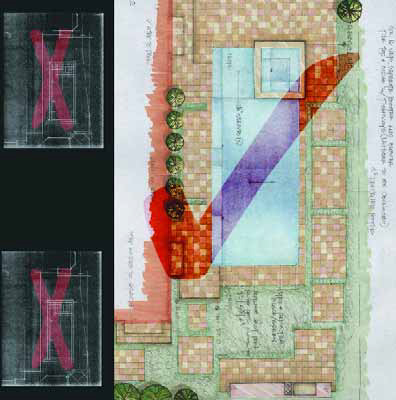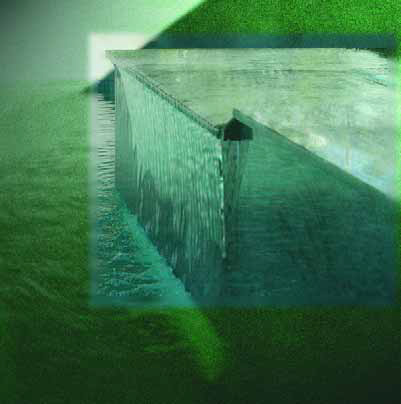pool design
When I was a kid in Caltagirone, Sicily, everybody worked hard all the time - grueling manual labor in the fields and factories. By the time I was eight years old, I was already working with my father in a ceramic-sculpture foundry. I didn't do much more than sweep the floors, but I was around all sorts of craftspeople and began to see that there were some forms of hard work that were more fulfilling than others. So I began to think about becoming a painter. I took my first steps in that direction at 13. By the time I was 18, I'd opened a studio and was painting and sculpting on my own. In those days, the arts community was an exciting place where we shared ideas, fed on each others' energy and competed with each other for good commissions. I'm not ashamed to admit that I thought the established artists I hung out with were cool and powerful in their own ways - and that I wanted to be just like them. Given the specific nature of my art, it's not surprising that the great Italian masters heavily influenced my work right from the start, including Michelangelo, Raphael and especially Leonardo Da Vinci. They are my heroes, and I see the work I do as a modest continuation of the traditions they established. These artists taught me that great art is about passion and the desire to
Where you've come from often has everything to do with where you're going. As a case in point, let me describe a project that had its origins all the way back at the very start of my work as a watershaper. My pool industry career began soon after I graduated from college. At the time, I was living in a garage in a rough part of Los Angeles and really wasn't sure what I wanted to do. I had studied ancient history, three-dimensional design and industrial design and had been accepted as a PhD candidate in pharmacology at the University of the Pacific. I was convinced I wanted to be a designer, but I wasn't sure which field I should enter. Then one day, at a time when I was about as broke as an organ grinder without a monkey, I answered an ad in the newspaper looking for
A couple months back, the National Association of Home Builders held its annual convention in Orlando, Fla. - a massive January affair that drew more than 120,000 attendees to view all manner of products falling under the broad umbrella of "home construction." One of the annual centerpieces of NAHB's event is the New American Home program. Each year, select local contractors build a state-of-the-art home in the show's host city to put the absolute cutting edge of residential design and construction on display. During the convention, show organizers sell tickets for tours, and thousands of people tour the home. Once the tours are concluded, the home is sold and becomes a deluxe private residence - and a lot of money from ticket sales flows to charity. I was fortunate enough to be asked to
Understanding the client is frequently the most important factor in creating a successful design. In the case of the project highlighted here, for example, it was a given that the clients were highly educated and knowledgeable with respect to design, style and materials: He's a top-flight graphic designer with an amazing grasp of color, line, architectural details, presentation materials and techniques; she's a degreed interior designer with a wonderful artistic flair. They're also two of my best friends: He and I taught together at UCLA and have known each other for more years than I care to admit. They've known about the focus of my business for years and said they hadn't wanted to call me because the project
Watershaping advanced by leaps and bounds from 1999 through 2004 – a journey of artistry…
Recently, I've been involved in the early stages of a project that has lent new meaning to the phrase, "seeing is believing." It came up as a result of a call from an agent for a well-heeled client who was interested in having me design and build a residential swimming pool in the Dallas/Fort Worth area. When I arrived in Texas, I was met by the owner's agent, David, and by Marcus Bowen, a landscape architect who was part of the large project team, which, I would learn, included architects, a landscape architect, an interior designer, a lighting designer, various engineers, numerous
It may have been in the heart of the depression, but 1932 was a good year for American swimmers: The Olympic Games in Los Angeles saw Clarence "Buster" Crabbe win gold in the 400-meter freestyle in the then-world-record time of 4:48.2 and Helene Madison win gold medals in both the 100- and 400-meter freestyle events. U.S. swimmers claimed nine medals in all, in many cases besting swimmers from the powerful and heavily favored Japanese team. The competition was held in an eight lane, 50-meter pool positioned quite literally in the shadow of the Los Angeles Memorial Coliseum. Just as the names and records of those swimmers have faded across 70-plus years, so too had the swimming pool and its companion recreation pool. Although they had remained in near-continuous use for generations, the old vessels were supplanted when a modern swimming pool complex opened on the nearby campus of the University of Southern California in anticipation of the 1984 Los Angeles Olympiad. Early in 2003, we at Rowley International of Palos Verdes Estates, Calif., were asked to renovate the old facility's two swimming pools. The City of Los Angeles, along with support from the Amateur Athletic Federation (AAF), set a goal that didn't involve
The late, great architect John Lautner is believed to have been among the first to conceive of and build a vanishing-edge swimming pool as a means of more directly tying views across the water into distant vistas. It's a landmark of modern aquatic design that has been emulated thousands of times in the 45 years since he designed "Silvertop" in Los Angeles, and it's wonderful to know that his spirit of innovation survives to this day in the company he started. The home and watershapes seen here are the work of Lautner's protégé and longtime collaborator, Helena Arahuete of John Lautner Associates (Hollywood, Calif.), who composed it all as a spectacular exploration of organic design principles and the use of water to express and magnify details of a setting while leading the
The late, great architect John Lautner is believed to have been among the first to conceive of and build a vanishing-edge swimming pool as a means of more directly tying views across the water into distant vistas. It's a landmark of modern aquatic design that has been emulated thousands of times in the 45 years since he designed "Silvertop" in Los Angeles, and it's wonderful to know that his spirit of innovation survives to this day in the company he started. The home and watershapes seen here are the work of Lautner's protégé and longtime collaborator, Helena Arahuete of John Lautner Associates (Hollywood, Calif.), who composed it all as a spectacular exploration of organic design principles and the use of water to express and magnify details of a setting while leading the
It's a setting of searing beauty and now features a home that is unquestionably a work of art. Designed by renowned architect Helena Arahuete of Lautner & Associates (Hollywood, Calif.), the structure sits on a privately owned, 2,000-foot-tall mountain known as Twin Sisters Peak - just part of an 1,800-acre estate in Solano County, Calif., that offers clear vistas of the Pacific Ocean, Golden Gate Bridge, San Francisco Bay, the Sacramento Valley, Napa Valley and the Sierra Madre Mountains as you turn around the compass. In the great tradition of "organic architects" from Frank Lloyd Wright through to Arahuete's mentor and long-time collaborator, the late John Lautner, the home takes full advantage of its setting, crowning the mountaintop with a glass-and-concrete hexagon that at once beautifies and harmonizes with the landscape. So fascinating is this structure and so prominent is its location that, during construction and ever since, private





















